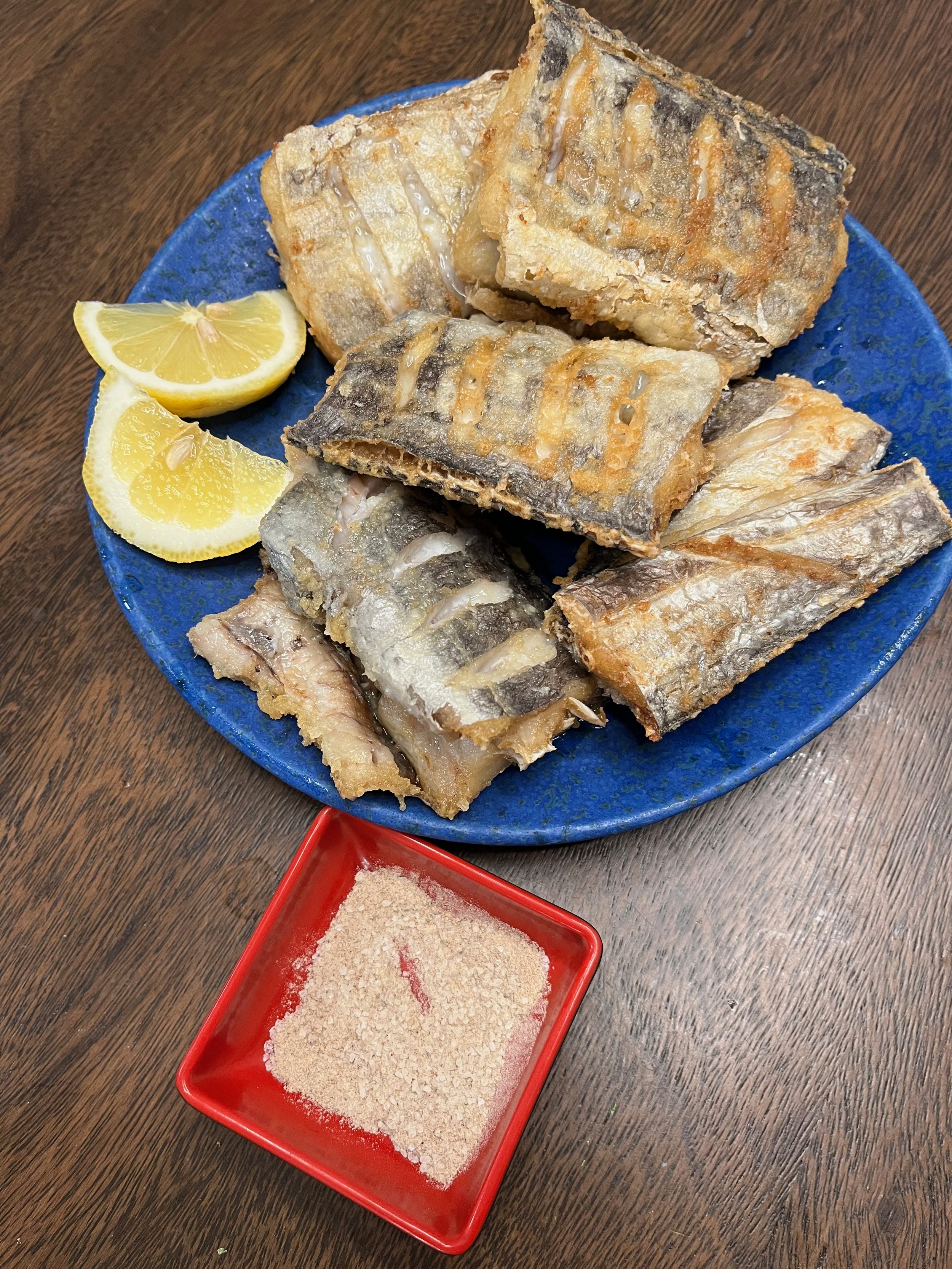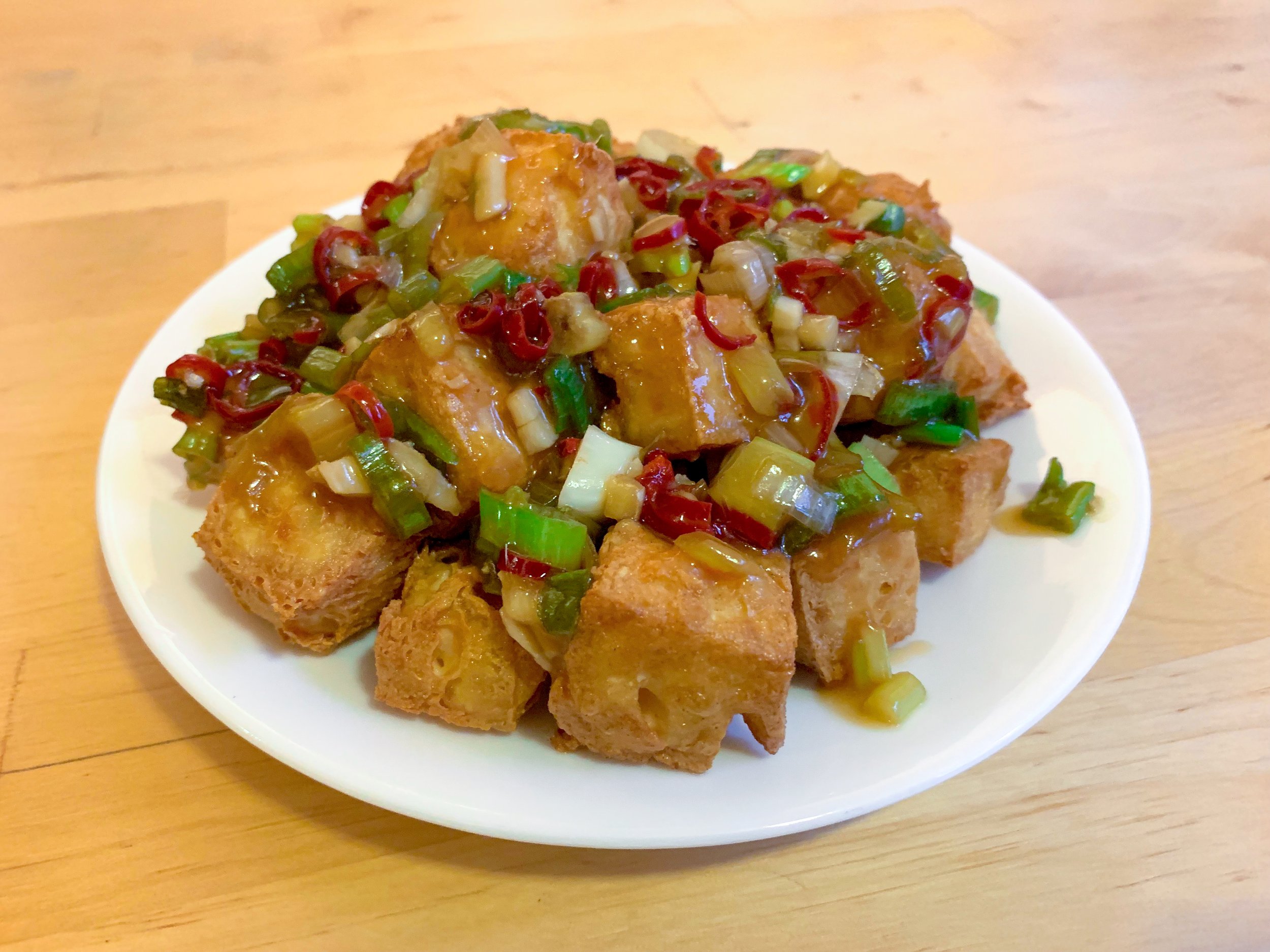Whole Pan-Fried Fish in Soy Sauce

醬油煎魚 (Jiang You Jian Yu)
Fried whole fish, with crispy skin and tender meat, and often doused in a fragrant sauce, is a delicious treat common at Chinese gatherings. Like most other celebratory dishes in Chinese culture, fish owes its place on the banquet table to a bit of wordplay. A common New Year’s blessing is 年年有余, wishing one to have a surplus in the coming year, and the Chinese word for fish, 魚 (yu), is a homophone for 余 (yu), the word for “surplus.” Thus it is considered good luck for the coming year to eat fish [1]. There are many regional variations of whole fried fish, using locally available fish species and paired with different sauces—some sweet, some spicy, some sour. This Hong-Kong-style fried fish is paired with a simple aromatic sweetened soy sauce!
Ingredients
For the Fish
1-2 lb whole firm white fish (snapper, sea bream, porgy, etc.), cleaned and scaled
½ tsp salt
3 tbsp cornstarch
Vegetable oil
For the Sauce
1 inch ginger, minced
2 cloves garlic, minced
2 scallions, chopped
1 tsp sugar
1 tbsp soy sauce
1 tbsp Shaoxing rice wine
½ tsp white pepper
1 tsp cornstarch
Fish is generally a delicate and lean protein, which responds well to steaming. You can use any small, mild, white-fleshed fish for this dish. We will look for a fish in the 1 to 2 pound range, which is small enough to handle easily in the home kitchen. Snapper, carp, and sea bass are common choices in Chinese restaurants, but this recipe also works with fish such as trout, tilapia, or branzino. The type of fish is less important than its freshness—in a lightly flavored steamed dish, there isn’t anywhere to hide. Look for a fish with clear eyes and no smell, and cook this dish within a day of buying the fish.
The fish should be scaled and cleaned—you can ask your fishmonger to do this. When the fish comes home, check for any remaining scales, and trim off any sharp fins with a pair of kitchen shears. Pat the fish dry with paper towels, including the interior. Then use a sharp knife to score the sides of the fish to a depth of about half an inch. This will help the fish cook more evenly, and also make it easier to eat at the table. Sprinkle salt on both sides of the fish and inside the body cavity, then dredge the fish in cornstarch. The cornstarch will give the fish a crispy coating, and reduce splatter when frying by absorbing any moisture released by the fish as it cooks.
In a wok or cast iron skillet large enough to hold your fish, heat about ½ inch of oil over medium-high heat, enough to immerse half of the fish. Fish is notoriously sticky, but a properly seasoned carbon steel wok or cast iron skillet should have a sufficiently nonstick coating. Do not use a nonstick pan here—those coatings cannot take the heat of shallow frying. When the oil is up to temperature, it is time to fry! The most dangerous part of frying whole fish is oil splashing out as you maneuver the fish. Hold the fish firmly by the tail and gently lower it head-first into the oil, laying the fish away from you. Do not drop the fish from a height into the oil!
Fry the fish for about 5 minutes without touching it, or until the downward-facing fillet is nearly cooked through, and a thin crust has formed on the skin. By this point, the fish should release easily from the bottom of the skillet. If it does not, either the fish hasn’t sufficiently cooked yet or the skillet is insufficiently seasoned.
It is now time to flip the fish. Again, we want to avoid any oil splashing out. My preferred method is to use a pair of spatulas to grasp both sides of the fish, then to carefully flip it over. Be mindful of the fact that the central body cavity of the fish may have filled with hot oil, and perform your flip accordingly. Now fry the fish for 5 more minutes, or until the fish is fully cooked. Then carefully remove the fish from the oil and let rest, ideally on a cooling rack placed over a paper towel-lined sheet pan.
While the fish rests, we can prepare the sauce. Heat about 1 tsp vegetable oil in a saucepan over medium heat. Add the minced garlic and ginger and fry the aromatics for about 30 seconds, or until they are fragrant. Then add the sugar, soy sauce, rice wine, and white pepper and bring the sauce to a simmer. In a bowl, mix 1 tsp cornstarch with cold water to form a cornstarch slurry, then pour the slurry into the saucepan. The cornstarch will thicken the sauce slightly, helping it cling to the fish. If the sauce becomes too thick, let it down with a bit more water. When the consistency of the sauce is to your liking, stir in the chopped scallions and remove the saucepan from the heat.
To serve, place the fried fish onto a large plate, then drizzle over the sauce. Serve immediately, while the fish is still crispy!
Substitutions
This preparation also works with skin-on fillets of a larger white fish, such as cod or halibut. If you are preparing this dish with fillets, reduce the amount of oil and fry the fish on its skin side until it is 80% cooked through, then flip once to finish it on the other side. For a bit of spice, add some chopped fresh chilies along with the garlic and ginger.
[1] There are other nuggets of New Year’s symbolism associated with a whole fish. Cooking a whole fish (as opposed to a cut of fish) represents the harmony of a whole (extended) family. Eating the middle of the fish, leaving just the head and the tail, is meant to be a reminder to finish everything one starts. When it comes to flipping the fish to eat the second side, are two distinct traditions. Some families will eat only one side of the fish on New Year’s Eve, saving the second side for New Year’s Day. Other families will flip the fish, but only allow the children to eat the second side. Both traditions speak to the same metaphor—to extend the surplus enjoyed now into the future, be it the coming year or the next generation.
Recipe
Prep Time: 10 min Cook Time: 15 min Total Time: 25 min
Difficulty: 4/5
Heat Sources: 2 burners
Equipment: wok or cast iron skillet, saucepan, cooling rack, sheet pan
Servings: 4
Ingredients
For the Fish
1-2 lb whole firm white fish (snapper, sea bream, porgy, etc.), cleaned and scaled
½ tsp salt
3 tbsp cornstarch
Vegetable oil
For the Sauce
1 inch ginger, minced
2 cloves garlic, minced
2 scallions, chopped
1 tsp sugar
1 tbsp soy sauce
1 tbsp Shaoxing rice wine
½ tsp white pepper
1 tsp cornstarch
Instructions
1. Pat the fish dry and cut off any sharp fins with kitchen shears. Score the sides of the fish with a sharp knife to a depth of ½ inch. Salt the inside and outside of the fish, then dredge both sides in cornstarch.
2. Prepare a resting place for the cooked fish by placing a cooling rack on a sheet pan.
3. In a wok or cast iron skillet, heat about ½ inch of oil over medium-high heat. When the oil is up to temperature, carefully put the fish in the skillet, laying the fish away from you.
4. Fry the fish for about 5 minutes, or until the downward-facing fillet is nearly cooked through and a thin crust has formed. At this point the fish should release easily from the skillet.
5. Use a pair of spatulas to carefully flip the fish, then fry for 5 more minutes or until the fish is fully cooked.
6. Remove the fish from the oil to the cooling rack and let rest.
7. In a saucepan, heat about 1 tsp vegetable oil over medium heat. Add the minced garlic and ginger and fry for about 30 seconds until fragrant.
8. Add the sugar, soy sauce, rice wine, and white pepper and bring to a simmer.
9. Prepare a cornstarch slurry with 1 tsp cornstarch and 1 tbsp cold water, and pour the slurry into the sauce to thicken it. Stir in the chopped scallions and remove the sauce from the heat.
10. Drizzle the sauce over the fish and serve immediately.
















